Square Foot Gardening - Is it a gimmick?
Yes, it is fun to grow more on less dirt, avoid weeding, and intercrop like a jigsaw puzzle, but how good is SFG? Is root growth compromised, or do plants reach their true potential?
I have gardened for a number of years and seen raised beds, intercropping, block planting, and other techniques. However, since discovering SFG a few years ago, I have yet to see a SFG garden where the plants did not look puny and under-producing in comparison to a conventional garden.
Am I missing something? Can anyone point me to online articles that show big hearty vegetable plants in a SFG garden, heavily laden bushy tomato plants, thickly vined cucumbers on a trellis, or huge greenbean plants with numerous greenbeans dangling under the canopy of leaves?
This is NOT a criticism of anyone who follows SFG techniques. I firmly believe that everyone has different goals in mind for gardening and there is beauty in self-expression through gardening techniques. What I am looking to find, is REASON ENOUGH for me to want to try SFG. By the way, I have read the SFG book and was not impressed. I just have to believe that there are gardeners on this forum who can do and have done better than anything that I have seen to date.
Comments (57)
tom_n_6bzone
17 years agoFour of the best reasons for SFG. Space, bad soil, labor and it invites new and old people alike to begin or begin again, GARDENING. Justaguy 2 called space, "small apartment living". That works for me. Do you have bad soil? You can manage excellent improvements with composting (which is an added benefit to SFG...it makes you want to compost because of Mel's soil mix) or even purchasing compost or a good soil mix because the smaller area is manageable. Once the initial raised bed(s) are complete, the labor is less and more productive than weeding. One small raised bed can make any # of people gardeners that wouldn't consider it before reading about Square Foot Gardening. Besides the apartment dwellers, there are disabled and older people or just plain people that can see SFG as something they can do. Production? Well, this method didn't claim it was for The Archer Daniels Midlands Group. ~tom
deep_roots
Original Author17 years agopenguingardener,
Your photo link was very helpful. It was like a James Bond movie. I have never seen so many different gardening gadgets in one yard before. Sometime, it would be nice to read a post about your different products and your opinion of them after using them. I liked the well-kept look of your setup, composting, hoop covers, self-watering, and the look of your soil. If I could suggest anything, it would be to make your growing beds deeper. I have included a link on this post that suggests 2' deep beds should be the normal. Keep experimenting and happy growing.Here is a link that might be useful: University Study on Raised Bed and SFG Bed Preparation
Related Professionals
Essex Landscape Architects & Landscape Designers · Peabody Landscape Contractors · Cudahy Landscape Contractors · Gaithersburg Landscape Contractors · Ponte Vedra Beach Landscape Contractors · Rockwall Landscape Contractors · Wentzville Landscape Contractors · Golden Valley Landscape Contractors · Shafter Landscape Contractors · Cherry Hill Fence Contractors · Clarksburg Fence Contractors · Corona Fence Contractors · Lady Lake Fence Contractors · Oakdale Fence Contractors · Zion Fence Contractorsdeep_roots
Original Author17 years agotom_n_6bzone,
You are right that SFG brings in a lot of new gardeners, as well as inspires a lot of older gardeners who miss their large gardens to start again with a more manageable SFG bed. I see a lot of novelty appeal to retirees.Maybe what is needed is Modified SFG. Most of the SFG setups that I've seen lack ideal soil depth and compromise growing by rigidly enforcing the square foot planting grid recommendations.
As tomatoes, cucumbers, cabbage, and other larger vegetables are desired over a plain onion and salad greens garden, maybe thinking 'outside the square foot' is a good new approach. If the typical SFG bed is 4' by 4', then maybe an online source of revised planting arrangements could be made. This would have pictures showing the trellis, cage, or other hardware used to get more versatility from SFG gardens. Tips like pruning off the lower branches on indeterminate tomatoes to allow underplanting with other vegetables, while allowing the upper tomato plant to grow more expansive could be added. Or planting larger plants like zucchini in the four corners where a lot of their leafs would extend over the edge of the bed would allow more room a tomato plant in the middle with greenbeans, onions, and leaf lettuce as fillers.
There is a lot of 'mystery' ooohs and aaahs about SFG. While I have not applied the 100% SFG technique, I am learning much about SFG in this post. Note that I do believe in interplanting, intercropping, succession planting, band planting, short row planting, vertical training, hoop tunnels, raised beds, and more. I am merely looking for a compelling reason to adopt SFG for my back yard.
Here is a link that might be useful: Intensive Planting - See Page 3 for Space Saving Techniques
tom_n_6bzone
17 years agoI understand what you are saying and your link has excellent and useful info. On page 3 of that link in table 2, it gives spacing for Band Planting in Approximate number of plants per square foot. 100 plants of carrots per square foot?! This might be confusing to SFG'ers as it is to me!
I like the idea of mini gardening using dwarf varieties when it comes to SFG. However, I don't think the consenses here approves of it. The smaller the raised bed, the more dwarfs (under Mini Gardening in your link) make sense to me.Your tips are good ones. I hope that you keep them coming!
~Tomdeep_roots
Original Author17 years agotom_n_6bzone,
The 100 carrots or 144 radishes per square foot is boggling to comprehend. Consider a square foot has 144 square inches. Now imagine you had a grid that separated the square inches. Now with SMALL radishes, you could drop one seed in the middle of each square inch. That is how they get a suggestion of 144 radishes per square foot. You might say, "What about when the radishes get larger?" Well, the secondary thing about the radish plantings is table use is assumed. So as radishes get more leafy, you will be thinning out the planting. For a production planting, you would pull all 144 radishes at an optimal size before they get too big and replant the area. Personally, I don't like to squint that hard when planting seeds. LOLPersonally, band planting works well for me when planting bush greenbeans. I plant in a relaxed grid pattern that puts 6" of separation between seeds in a block row that is 24" wide. Any wider and it gets more confusing trying to fish out all the greenbeans, plus I like to straddle the rows when picking. It is amazing how quickly I can fill a bucket with greenbeans when planting this way. Additionally, the leaf canopy shades out the weed growth.
While band planting is a good technique, I do not recommend it for all vegetables.
deep_roots
Original Author17 years agopenguingardener,
While not having read "Cubed Foot Gardening" by Christopher O Bird, I have read reviews that say CFG is not much different than SFG. While allowing more room for plants to grow is allegedly recommended, he also is a strong supporter of chemical fertilizers, chromate arsenic treated lumber, and frequent insecticidal spraying. Have you found any of the book that differs from the above statements that I've read?penguingardener
17 years agodeep_roots,
Although I believe that Bird's book has suggestions that sway against organic practices, I thought of it mostly because of your suggestion regarding higher beds or double-digging.
I guess I had forgotten about those items and only remembered the deeper beds part. I was asking if that may be along the lines of a "modified sfg" you were suggesting.
BTW, that's a handy document you posted on Small Plot and Intensive Gardening, thank you.
deep_roots
Original Author17 years agoOne of my biggest reservations about SFG is the late summer to end of season appearance of many SFG gardens. I frequently see plants that are stunted,have yellow-leaves, or exhibit signs of viruses, blight, and insect damage.
These appear most common in shallow crowded SFG raised beds.Picture of underperforming plants,
http://www.frostcall.com/?p=21Picture of diseased plants,
http://www.magnesium.net/~ipontific8/garden/090301/90301_1.jpgRegarding the common 6" SFG bed depth, tomato growers who grow in deeper 5 gallon buckets often have better results, with those growing in 15 to 20 gallon containers having even better results. Neither of which have as good of results as open ground growers.
I suspect that root competition, lack of nutrients, occasional drying of root zone, and limited growing area typically catch up to the SFG garden about halfway through the season. Following is a picture link from June showing half-way decent looking plants close to their peak appearance for the season.
http://www.magnesium.net/~ipontific8/garden/062401/boxmid.jpg
Is there anyone who has created a deep SFG on top of tilled soil or uses innoculants (http://www.bio-organics.com/) or Aerated Compost Tea? I would like to hear or see the results compared to what I have seen on the Internet. If not familiar with aerated soil drenches, try google search or the following link as an example.
Here is a link that might be useful: One of many aerated soil enhancers
deep_roots
Original Author17 years agoFound this interesting link that shows how someone put raised beds terraced into the side of a hill, along with 5 gallon buckets for trellised tomatoes and snap peas. I noticed from the picture that a timer is used to control drip irrigation to the plants. The concept of overcoming poor soil with a compact growing system was interesting to me in that I could compare it to SFG. See for yourself and make your own opinions.
Here is a link that might be useful: SFG Comparison, Here is raised bed and 5 gallon bucket garden
justaguy2
17 years agoI am merely looking for a compelling reason to adopt SFG for my back yard.
Because you want to? ;-)
Seriously, a 4'x4' bed to experiment with is very affordable and allows you to use the method with no variation. No skimping on Mel's mix, use the grid etc.
Then you will know if you like it or not.
A good way to poor results is to grow intensively in regular soil, low in organic matter.
A quality, well aerated mix with 33%+ quality compost is a different animal altogether.
Sooooo many people think they are square foot/intensive gardening when really they just framed in an area and filled it with yard dirt and dumped a bag or so of store bought compost/manure on it and called it a day.
Those gardens will under perform, predictably.
To get a lot out of very little space requires no short cuts when it comes to soil quality and fertility.
eswar
17 years agoSquare foot gardening made gardening easier for some and now several companies are selling raised bed kits.
It gave a chance for people with bad soil, limited time, small yards to garden.
Like every thing MelÂs methods can be improvised.
6 inches of height is good for some vegetables only. Now one can make 2 tier squared foot garden one 6 inches and the other12 inches.My three feet by 3 feet raised bed kit is from GardenerÂs supply and made in England.
It is 9 inches in height. It is better than 6 inches which Mel recommends.Some may not use the recommended 1/3rd vermiculite. It is expensive and not easily available in 4 cubit foot bags every where.
Adding compost from 5 different sources may be difficult for some living in rural areas.I think even the recommended MelÂs mix can be improvised. The only source of nutrition for plants in Mel's mix 1/3rd compost.
I add Osmocote and sea weed (kelp) for minerals or any Epsoma fertilizer available such as Garden tone. I do use foliar feeds at the recommended temperature at half strength.
This year I will use little liquid calcium.
I do like MelÂs tower. It is easy and looks good and can be taken out when one relocates. It can be made at 2/3rd cost than what is the selling price.There is nothing that can be improved. If Mel"s mix is expensive one can use AlÂs container mix, but still you need vermiculite, but slightly lesser quantity
plot_thickens
17 years agoVoice of dissention --
I think that SFG is not as effective as some would wish. The most productive gardens I have ever seen were Organic French Intensive (raised), where a nearly closed circle between the garden and the kitchen kept things in beautiful health. Mulching, no weeding, no soil cultivation.
SFG makes people think that an equation can be applied to gardening to come out with an 'A' grade garden. Unfortunately, that's not always true. Gardening, like any hobby that has a deep and rich history, requires study and knowledge gathering. A person who's strictly followed the SFG philosophy for 20 years will not have as good a garden as one who's incorporated other methods into their personal gardening philosophy.
This in no way discounts SFG. It's a great way to get folks started on gardening, and helps them think about it in a very user-friendly, practical manner. It's a wonderful stepping stone from Albertson's to your back yard produce section. I recommend it. It's just not the be-all, end-all to gardening...there's no replacing your own observations and learning.
beeziboy
17 years agoAfter many years of row crop gardening, I have given up on that system. I prefer the square foot way as then I can experiment on a small scale to my heart's content.
By using plenty of compost, I have done away with commercial fertilizers and pesticides.
Here is a link that might be useful: Garden Corners
squareftgardener
17 years agoNew to the forum but not SFG. This my 3rd year using the SFG way to plant. My soil was the 1st reason I went with SFG. I don't have any. My house is over 100 yrs old and has been used for just about everything. My back yard was used as a parking lot and is gravel with about 2 inches of top soil. The 2nd reason is because I work odd hours and don't have a large amount of time to invest in gardening. I have the following beds all with grids:
4--4x16
1--2x16
3--4x4
7--2x8
1--2x6
1--2x3The 4x16's are filled with river bottom dirt with some compost & manure added. The rest of the beds are filled with Mel's mix. I use 2x8' lumber for all my beds with the exception of 3 which are 2x12 but that is another story. I do put about 2 inches of sand in the bottom as a filler for the 2x8 beds. Last year I had tomato plants in both dirt and mix beds. Same kind of plants but the ones in Mel's mix did much better and they even had less sun due to their location. The ones in the mix were in a 2x8 bed and I had 8 plants in there. Never cut a sucker and they were at leats 8 feet tall. We had slugs in the dirt beds and none in the mix. Even with heavy mulching in the dirt beds the weeds were a problem but not in the mix. I planted garlic in the mix this past fall in between rain showers which I couldn't do in the mud of the other beds. I had a few of the garlic come up which were obiviously 2 plants. I moved them out of the mix, seperated them, and replanted them with no problem.
I grew up with a hoe in my hand but not any more. About the only tool I use now is a rake to smooth out my mix.
My planting list:
Onion
Radish
Carrot
Cucumber
Tomato
Garlic
Watermelon
Cantaloupe
Leaf Lettuce
Bush Beans
Pole Beans
Hot PeppersHere is my opinions on SFG:
Gimmick--No
Initial high cost--Yes
High maintenance--No
Enjoyable--Yes
Time consuming--No
Relaxing--Yes
Neat--YesWhat it really comes down to is that if something works for you then go with it. If it doesn't work for you then try something else. There will always be new avenues to take and new ideas to try. Improvements can always be made but if it's not broken don't fix it.
deep_roots
Original Author17 years agoMaybe justaguy2 is right that I should just try a SFG trial this summer. I am curious whether plot_thickens has any Internet references or pictures of those Organic French Intensive (raised) beds, as I am also curious about those.
I will admit that the SFG beds of beeziboy seem to be among the better looking ones that I have seen. The growth looks healthy and vigorous. Although the watermelon and muskmelon appear to have smaller fruit than open ground grown plants and fewer melons, the tomatoes are loaded with good sized fruit. What variety are those tomatoes beeziboy? Also, it appears some of your plantings are not spaced as close as typical SFG rules suggest. Do you use different spacing?
The other thing that eswar and squareftgardener have me considering is bed size. A 4' x 4' bed is difficult to reach into the middle. Regarding eswar's 3' x 3' bed or squareftgardener's 2' x 3' or 2' x 6' beds, I wonder if they perform any differently than larger or more square beds?
eswar
17 years agoWhy do I use 3by 3 feet beds?
I am short 5ft 4 inches tall. It is easy for me to reach.
Semi retired 65 years.
Smaller home- Smaller yard. Moved to a smaller home 4 years ago. Had an acre and half garden before. The gardens of my friends who still live in their big houses with big yards are in a bad shape. Difficult to maintain due to age, health reasons, taking care of grand children, trips, kids and their divorces etc. Gardening should be fun and not a chore.Follow Anderson, Reams, and Beddoe fertilization guides
(Book "nourishment home grown "by AF beddoe)Different plants needs different fertilization needs. The needs of fertilizers (quantity and type) of vegetables are different in the first month, second month and third month.
Leafy Vegetables are grown in 5 dollar and 12 dollar 7 inch depth swimming pool planters.
I feel 9 inches depth is better than 6 inches. The kit 3 -3 feet was on sale for 33 dollars at GardnerÂs alive at that time. If a 12 inches kit is available I will buy one. I am not handy in making things.
I am a vegetarian and I do not eat canned food.Hence I enjoy growing vegetables.
deep_roots
Original Author17 years agoIn thinking about 4' x 4' SFG beds, I have considered the following possible planting groups as possibilities for a trial SFG bed. If anyone who has SFG experience wants to comment, please do. In conducting a trial, I would like to be successful.
(4) Tomato Plants
Divide the 4x4 into quarters and plant one caged inderterminate tomato plant in each of the 4 quartersor
(16) Cucumber Plants
Divide the 4x4 into the typical 16 one foot squares and plant one cucumber plant in the middle of each square foot and let the vines rambleor
(16) Sweet Corn Plants
Divide the 4x4 into the typical 16 one foot squares and plant one sweet corn plant in the middle of each square footor
(9) Muskmelon Plants
Divide the 4x4 into the typical 16 one foot squares and plant one muskmelon plant not in the middle of a square foot, but rather at the nine points of intersection where the grid lines intersect and let the vines rambleor
(9) Summer Squash Plants
Divide the 4x4 into the typical 16 one foot squares and plant one squash plant not in the middle of a square foot, but rather at the nine points of intersection where the grid lines intersecteswar
17 years agoSquare foot garden efficiently addresses the optimal utilization of the space available with ease and without lot of labor.
The wooden grid some may call it as a gimmick and an ornament over planting area, but it gives an idea which can be improvised upon as the situation demands.I find that even increasing the space between one plant and another marginally(1.5 times) and increasing the depth more than 6 inches works well.
It addresses increasing the yields per plant, by better aeration, water retention., And suggestions for vertical growth. But I do add my own fertilizer and supplement with foliar feeding when necessary.gardener_mary
17 years agoIf its a gimmick, its one I like. The thing that I like best about the book in general is that Mel is not preachy. He does not say that his ideas on gardening are the only ideas. He tells us all about his experiences with gardening and lets us use the parts the fit our need and put aside those that don't. He doesn't say that you have to follow his plans to a tee, he advises to adjust things to fit your own needs.
The most important thing that I learned from the book is to plant what you want to eat - limiting the number of plantings at one time and stagering planting to get a longer harvest. I use a mix of SFG, intensive, container gardening and any thing else that fits at the time.
My personal advice on growing tomatoes in 12" spacing is to use the trenching method used in the book and to put some organic fertilizer in the bottom of the trench before you put in the soil. The root will grow down deeper to get to it.
I've had good experiences growing tomatoes up a string on a frame. I find it alot easier than trying to keep tomatoes tied up to stakes or cages. Just my experiences, we each find our best way. Enjoy what ever method you choose to use.
good gardening
Maryalexjh
17 years agodeep_roots, SFG appeals to me because I'm an engineer, I like the structure of it. Planting in rows just doesn't make sense when you look at it from an efficiency point of view, for a single gardener. A large, machine harvesting operation needs rows obviously, but for one person, I think SFG is better.
(4) Tomato Plants
Divide the 4x4 into quarters and plant one caged indeterminate tomato plant in each of the 4 quartersI don't think that method would be recommended in the book for two reasons:
- trellises are recommended because they can be laid out in a line on the north side to maximize sun inside the square
- harder to harvest toms on the inside point between all of the cagesHave a look at the spacings recommended here:
Here is a link that might be useful: Square Foot Spacings
plot_thickens
17 years agoIntensive / Biodynamic planting has many things in common with SFG, but is less 'Easy! Quick! No Work!' hype and more "you get what you put in" in-depth study and mindfulness. And it's true. It's very cool how much you can grow. (Think: SFG's wise old grandmother whose hands are never empty).
This is a great article about B/F intensive: beginnings, expectations, results.
http://www.motherearthnews.com/Organic_Gardening/1980_January_February/Biodynamic_French_Intensive_GardeningOther excellent resources:
http://www.frenchgardening.com/aupotager.tmpl?SKU=3104884985285027
http://www.commongroundinpaloalto.org/eventandfriendsphotos.htmOoo pretty pictures
http://www.commongroundinpaloalto.org/gallery/Imager.asp?Dir=/2004%20Glorious%20Garden%20TourAnd link after link after link
http://en.wikipedia.org/wiki/Biointensive
http://davesgarden.com/terms/go/496/
http://www.minifarms.com/Silly premise, some pictures
http://www.endtimesreport.com/gardening.htmljustaguy2
17 years agoSome good links there, plot!
I think Square Foot Gardening has brought French Intensive mainstream albeit with modifications.
I have read some of the French intensive material and came away thinking 'Wow! That really is intensive [work].'.
I think Square Foot Gardening is French intensive goes modern, but at the same time there are elements of Square Foot Gardening that I think many would do well to experiment with to see what works best.
I think one of the great appeals of Sq Ft Gardening is that it is encouraging to new gardeners as well as long time gardeners who end up saying 'I love gardening, but I am starting to question if it is worth all the work I put in each year.'
I have yet to see an easier way to garden and get results as good (although Earthboxes and similar self watering/fertilizing setups are good too). I can think of ways to get even better results (for larger crops), but without exception they require more work.
To my amazement I still encounter traditional row croppers who have gardens just for themselves and their family who devote a quarter acre or more of their land to the family garden. Each year they spread the amendments, fire up the roto tiller and engage in heavy labor. It seems absurd to me given my personal priorities, but to each their own.
I do think one can 'do better' with some aspects of French Intensive than they can with Sq Ft. *if* they wish to do more work.
That's a big if though, and it is up to each person to decide for themselves.
As long as it feels like fun and not work as far as I am concerned one is doing it 'right'.
eswar
17 years agoThe first book I purchased about gardening in early eighties is by John jeevons"how to grow more vegetables"
I hired some one to double dig due to lack of time added faithfully Soft Rock phosphate, high calcium lime, green sand, kelp Etc.
Now due to age factors I wonÂt do it again. I am getting slowly out of containers to square foot gardening and self watering troughs.
Experimenting is fun part of gardening. There is nothing to prevent one from making a 12 inch or 18 inch depth square foot garden. Mine are 10 inch plastic beds from Gardeners supply and 12 and 18 inches cypress beds from blue grass raised beds. I still use old fashioned rock phosphate, sea weed, kelp and fish emulsion sprays. .
Less work, gardening is more enjoyable. The sacrifice of a small percentage of yields per plant, if at all is worth whiledeep_roots
Original Author17 years agoI should have known that the square, the grid, and the angles would appeal to an engineer like alexjh. It would seem that most folks are using the SFG plant spacing guide and vertical trellises. So using the SFG planting guide or even eswar's 1.5x relaxed plant spacing will likely be what I use for my trial bed.
I notice that eswar uses organic fertilizer versus the typical miracle grow 15-30-15. I have used water soluble, slow-release, and organic fertilizers successfully. I can not find the Anderson, Reams, and Beddoe fertilization guides from the "Nourishment Home Grown" book by AF beddoe that eswar uses. Regarding the changing fertilizer needs of vegetables in their different growth stages, eswar can you give me some details of this? Also what has worked for SFG gardeners reading this post? Are you using synthetic or organic fertilizers?
The links to French Intensive Gardening by plot_thickens were very interesting. French Intensive Gardening seems to differ from SFG in two primary ways to me. French Intensive concentrates on creating a living soil web with empty spaces continually replanted and soil fed so it will feed the plants. Secondarily, SFG seems more focused on a man made system of neat looking wooden squares and hardware where planting is thought of in one foot squares versus looking at the typical 4 foot by 4 foot bed as a ecological system. It would seem that the two systems could be somehow blended. Note that I found another supporting article for French Intensive Method on Mother Earth's web site. I've included the link.
Here is a link that might be useful: Mother Earth's Mini-Garden Experiment
eswar
17 years agoNourishment home grown is available from this website. It is sold out, but expected to be available in the third week of March.
It is a technical book. But lots of information and makes sense to me.
I am using Cary reams methods from 80s.Some of the links provided at this site gives some general idea
http://home.woh.rr.com/billkrisjohnson/Garden/GardeningforMaximumNutrition.htmdeep_roots
Original Author17 years agoWow! eswar, that is one jam packed website. I will be doing some serious reading tonight. If you are combining eco-farming with square foot gardening, then I am most curious about your results. Do you find any particular vegetable plants flourish more than others in your setup. Additionally, if you could provide any pictures of your setup, that would be great. Concerning Dr. William Albrecht, Ph.D, I was more interested in his soil sample and analysis recommendations than his philosophies. While I agree with using rock dust for long term soil amendment, I also think that the newer brewed compost teas are very healthy for plants. I like a soil that is like chocolate cake in consistency with organic matter, worms, and a balanced soil sample ratio. If the dirt looks alive, then I am happy. This is one of the reasons that I thought SFG was not producing as well as it could for most people. I don't see Mel recommending the feeding and care of the 'potting soil mix' that SFG endorses, which would be needed to make it more 'alive'. It would seem the concepts of SFG are more easily understood than the concepts of biointensive sustainable gardening. Also, thank you for the heads up on the book availability in March.
eswar
17 years agohttp://www.aglabs.com/newsletter.html
The news letters give good explanation of the principles.
It is not expensive.
I do not use any designerÂs fertilizers.
I use common things like molasses, compost, High calcium lime, soft rock phosphate, fish emulsion,calcium nitrate, sea weed and few foliar fertilizers.
Since these are geared towards farmers, I do not post about them.
For my 60th birthday some one gave me a Digital camera as a gift. Still it is in the box.
Ohio earth food is the place I buy them from. The advantage is the basic stuff you need to do once or twice. That is all to it. The effects are long lasting.deep_roots
Original Author17 years agoRegarding my soil, eswar here are my last soil test results. I am still working on improving my garden and expect the soil to be in even better shape since this old test. I appreciate the information you shared. Regarding your source of materials, I have included another link for the Gardens Alive store. This is another good source. You mentioned using "molasses, compost, High calcium lime, soft rock phosphate, fish emulsion, calcium nitrate, sea weed and few foliar fertilizers" I like all those products. Note that you might consider adding a little surface scratched alfalfa that contains triacontanol plant growth stimulant. The Sea Kelp that you use, also contains a plant growth stimulant. One of the things I would like to do is brew / aerate a batch of fish emulsion, sea kelp, alfalfa meal, calcium nitrate, and a little molasses to make a plant and soil drench this year. I am curious how much punch this will give my plants.
19.7 C.E.C. (target 20-40)
5.3 Org Matter
5.8 Soil pH (target 6.7-6.9)
64 Lime Index
161 P lbs./ac (target is 70)
296 K lbs./ac
4304 Ca lbs./ac
332 Mg lbs./ac
55% Ca Sat'n (target 65-70%)
7% Mg Sat'n (target 10-15%)
2% K Sat'n (target 2-5%)
63% Base Sat'n Ca + Mg + K + Na
7.8 Ca/Mg ratio (target 5-8:1 Ca:Mg)
3.7 Mg/K ratio (target 3:1 or higher Mg:K)
151 SO4 lbs./ac
0.9 B lbs./ac
2.1 Cu lbs./ac
23 Mn lbs./ac
16.5 Zn lbs./ac
192 Fe lbs./acHere is a link that might be useful: Gardens Alive Environmental Growth Products
eswar
17 years agoFermentation is a traditional farming practice with Asian cultures. I learnt this first from a Japanese lady 75 year young, who actively gardens. I live in Kentucky. Toyota plant is in KY.
This works. I do it on a regular basis. I water the plants supernatant fluid .I also use alfalfa and also corn meal or Soya bean meal. They are cheap. Here 100 pound bag in a feed store costs 8 dollars. All you are doing is increasing the bio availability and lessening the work load for soil bacteria.
I add either dry or liquid molasses. The Japanese add rice bran sauce for fermentation. I use a 5 gallon buckets and a bamboo stick for stirring.
Worms way sells good aerators for 17 dollars.
The essence of what you are doing is bringing the soil to balance. My yard and gardens where I brought them in balance in early eighties still performs better than many others.
Fish powder is cheaper than liquid fish emulsion. It is available in 2 grades. Do not skimp on molasses.
Gardens alive are good for using 25 dollar coupon for purchases above 50 dollars.
People also add sugar at a rate 20 pounds for acre.deep_roots
Original Author17 years agoI really enjoyed reading all the linked references, especially the following:
High Brix PlantsI agree with adding soil amendments, growing cover crops, building bacteria, feeding microbes, and innoculating with mychorizza fungi. What was interesting was that this article explained what happened to me. I added several decomposed straw bales one year and a six inch layer of composted manure another year. However, the additional Nitrogen in my fertilizer fueled the microbe community into consuming practically all of my organic material.
Regarding foliar feeding and soil drenches, I found the following small video of John Evan's and his brewed tea. It is inline with the post about Asian culture and homemade liquid supplements.
small movie on brewing compost teaI would like to get eswar's recipe for his foliar sprays and drenches in regards to both proportions and instructions in order to try it this summer. Also, how often are you applying this solution? I read that 6 to 8 times per season is the best frequency for foliar feeding. However, I know others use foliar feeds or soil drenches once per week. For those doing 24 hour aerated compost teas, I also saw where someone created a commercial brewer that did not use a aerator. Instead, they pumped their brew up a tube and then let it run down over board back into the bucket. This apparently gave more oxygen across the surface of the solution than would be introduced by an air pump directly into the bucket. eswar, feel free to private message me at the following address, should your foliar feed not be a 'public' recipe.
private messagealexjh
17 years agoI should have known that the square, the grid, and the angles would appeal to an engineer like alexjh. It would seem that most folks are using the SFG plant spacing guide and vertical trellises. So using the SFG planting guide or even eswar's 1.5x relaxed plant spacing will likely be what I use for my trial bed.
If I could find a way to fit 'pi','e', or the golden ratio into my garden, I would! :D
plot_thickens, thanks for the links!
eswar
17 years agohttp://www.aglabs.com/newsletter.html
Since this is copyrighted material I can not post this.
There is a news letter in the above website dedicated to growing tomatoes. It discusses freely how to change/switch from growth phase to flowering and fruiting phase.I think there is also a discussion about the different fertilization needs of leafy vegetables and for the vegetables grown for their fruits.
The book "Nutrition home grown" is a technical book and gives lots of information that works. Wait for a month to get this book or one can borrow it from some one.
I usually get most of fertilizers etc from feed stores and agricultural supply stores. They are cheaper; there is no hype and promotional write ups
Foliar feeding receives a publicity that it does not work. How ever If done right!justaguy2
17 years agoEswar,
The link you provided is to a site more or less dedicated to Dr. Carey Reams. Are you familiar with him? The man claimed to have gotten his best information directly from God during a period of prayer and fasting.
He claimed to have cured cancer in over 10,000 patients in a single year (that breaks down to 27 patients per day).
His biological ionization hypothesis has been completely discredited, a long time ago.
He seems to believe that calcium should be used in incredibly large amounts for people and plants.
I guess what I am asking is what is it that you find worth recommending from this site?
gumby_ct
17 years agoFrom the Reams site -
"I am writing this on March first and the weather is great."Hope he is right!!
kiwiblossom
17 years agoLots of good stuff here! I came across SFG when hunting for a book on intensive gardening I had lost. I believe the simple formulaic approach will appeal to first-time gardeners, but why not? It's easy to remember, and it's a good basis for actually getting started, and that's the beginning of learning!
I have my doubts about the 6" soil depth too, and wonder if they might work better in sheltered areas with short, warm summers. Curious to know how people adapt SFG to their locations!
Gardens that fade out - maybe this is particularly common when people only garden in summer? The SFG book recommends adding a good dollop of compost every time a plant is removed, but perhaps we don't do that when we're not really thinking about autumn planting? And for the same reason, if we are not planting legumes and practicing the kind of rotation he recommends, we may not be getting the results?
As for availability of compost, I find that while flash garden centers surprisingly don't always have a good range, they are out there if I look, sometimes in odd places (my local source is a tropical fish shop which sells about 3 potted plants and a huge range of composted manures!!)
penguingardener
16 years agodeep_roots,
Did you wind up doing any sq ft beds this year? I thought I'd post an update on my 2'x8' bed (which is about 3" high).
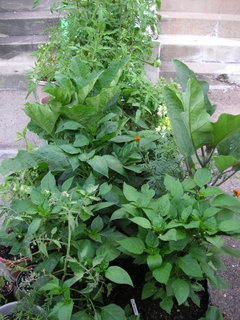

I do find myself pruning the tomatoes. I packed in: 2 tomatoes, 2 eggplant, 5 peppers, marigold, snapdragons, flat and curly parsley, basil and oregano. The photos were taken yesterday before I started any maintenance (like pruning and weeding).
I made this bed when I realized the garlic in my 2 3'x4' beds were going to take longer than originally planned.
chosemerveilleux
16 years agoGood day folks,
I am getting ready to build planter boxes for a large, mostly unused concrete patio. I was intending on starting with two 4x6x2ft high planters and going from there. I live within 10 miles of the ocean so the soil is pretty much sand. When redoing my lawn I used spent mushroom substrate (mushroom soil) on the recommendation of Mike Mcgrath from You Bet Your Garden with resounding success (45,000 lbs for 7,000 sq feet of lawn). Would using mushroom soil instead of the soil typically used in mixes work well? Nitrogen and phosphate numbers for mushroom soil are extremely high-so high that this spring was the first time I added fertilizer to my lawn since spreading the mushroom soil three years ago! I also had a question concerning drainage of the planters. I have read a few articles saying that drainage of a planter box placed directly on a concrete slab isn't a concern. Is this the case? I was intending on putting a layer of river stone on the bottom with the soil on top, but will I need to cut drainage holes in the base of the sides of the box (to be made with composite wood boards, so rot isn't an issue) I was also considering using drip irrigation for watering. I have a sprinkler system installed for my lawn, so adding a zone or two for a garden will be simple. Anyone having success with a drip system? Cheers in advance for any comments, and my apologies if this isn't the appropriate section for this question. Cheers,
Djustaguy2
16 years agoWould using mushroom soil instead of the soil typically used in mixes work well?
It might, but it wouldn't be my first choice in a container. For containers (and a raised bed on concrete is just a large container) I prefer a material that doesn't break down rapidly. It just results in the depth of the container shrinking dramatically over the season and often results in a growing medium that retains too much water for some plants.
Still, there are those who report good success with mushroom compost.
As far as drainage on a patio, the stones won't help you at all. All you need is a drainage hole that is unobstructed.
Elevating the box off the ground even 1/4 inch will help ensure the drainage holes on the bottom can drain freely. Also using plastic window screen over the holes helps keep them clear of obstructions.
Drip systems and soaker systems work really well with containers. The thing to keep in mind is that the water fans out as it goes deeper and it isn't uncommon for there to be dry areas on the surface while the media an inch or two down is well watered. This is really only of importance early in the growing season if you are sowing seeds or extremely young transplants without a good root system. In such a case a little hand watering until things are established with deeper roots is sufficient.
chosemerveilleux
16 years agoCheers for the information. I'll be sure to put it to good use.
Cheers,
Dseedsilly
15 years agoI'm 2 years late to this party ; )
Deep Roots said
"With single stem tomato plants, Urbana, Illinois, studies saw around 6.5 pounds of tomatoes per plant. With unpruned tomato plants, production was around 19.6 pounds per plant"Doesn't that demonstrate the benefits of SFQ? In a 3x3 space, with one plant, tomato yield would be 19.6 lbs. That same 3x3 space, with 9 single stem plants, yield would be 58.5 lbs (9 x 6.5 per plant).
I know I'm probably talking to myself, that's nothing new!
gardener_mary
15 years agoseedsilly,
I believe you are correct. I find growing tomatoes this way to be much easier, I can plant more varieties in my space and I get good yield.
It may be an old topic, but to my thinking still a good one.
Good gardening, Mary
deep_roots
Original Author15 years agoNew breath into old post? Since starting this post two years ago in February 2007, I have done some trials in SFG. While I currently have Mel's mix and lumber to create a 4 foot by 4 foot by 1 foot deep SFG for summer 2009, I have used a 2.5 foot by 12 foot by 1 foot bed over the past two years. There are a lot of results to share, however here a few points. Drainage was not a problem, but moisture retention was. I found myself adding tremendous amounts of peat moss the year after my first trial in attempts to keep more moisture in the soil. Second, compost broke down rapidly with the heat of the raised bed being higher than my in-ground plantings. Re-application of compost was needed more often. In spite of placing the bed on top of good gardening dirt, plants would often only root in the looser soil of the raised bed and not go any deeper. Also, not all of the plants grown in-ground did as well in the raised bed. In particular vining plants did not do as well. Small intensely planted vegetables like onions were difficult to weed after being gone on vacation and coming back, with rapidly growing grassy weeds effectively outgrowing and overtaking the onions. Tomatoes and summer squash did quite well and were the best performers. My summer 2009 plans are to put out a new SFG in traditional 4' x 4' x 12" layout and apply some tweaks to see if I can improve on prior years results.
Dan _Staley (5b Sunset 2B AHS 7)
15 years agoIn particular vining plants did not do as well.
Deep,
do you think this was due to the higher soil temperature or lower soil water content? Also, do you think deeper incorporation will give you more soil volume and thus more soil water? Lastly, I'm interested in your weed comment and do you think some sort of mulch will help your weed issues?
Dan
deep_roots
Original Author15 years agoDan,
Using a temperature probe, I found my SFG soil temps were within the 50 to 70 degree range for most of the season. Toward the fruiting stage at the end of July and beginning of August, soil temperatures would climb above this range.Regarding weeds and mulch, I was using an organic approach and did not use a plastic mulch so my soil could sustain more microbial life. I did try a loose straw mulch and found that the straw cut down on weeds, but did not totally eliminate weeding. The straw required additional nitrogen fertilizer to replace what it used in decomposition.
Water management definitely was lacking. Working in an open area with intense sunlight and drying winds did not help the already fast draining SFG. The inability to guess what my watering needs would be each morning, likely was one of the biggest culprits. With the plants unwilling to send roots deep into the less desirable soil under the bed, they were more susceptable to water stress too.
Because I used an organic approach, I became very successful at fostering a living soil that rapidly broke down compost and organic fertilizers. So much so, that I would almost watch the compost disappear before my eyes.
Slow release fertilizers are not a great alternative either, as they seem to be heat activated. A large release followed by smaller levels of available fertilizer is seemingly what happens.
I do think that a deeper SFG with more frequent watering might help. I am considering using a water-based or slow-release fertilizer combination. Since, I would not use organic fertilzer this time around, a plastic mulch might be used. I might even consider a shade cloth for the end of season hot days.
Dan _Staley (5b Sunset 2B AHS 7)
15 years agoDeep,
Sounds like we have some similar issues to overcome - mine are sunlight at 5700 feet, low humidity and much, much dessicating wind.
I'm organic as well until the better half comes in behind me with the liquid Miracle-gro. I find the compost and organic approach really helps with nutrient availability and a fert-moisture buffer in the soil.
I'm lucky in that my beds went in over heavy clay on a slope, and forking down amendments another foot-18" on top of that gives me excellent water holding capacity and a large soil volume, altho my bed is behind Allan Block and the soil temperature needs active management.
I noticed last year in the heat our vines didn't do well either and am looking for a decent strategy to keep the soil temp manageable so their roots stay cool. We're leaning toward straw erosion mats to this end and for water retention. I'll pass on results when I know...
Dan
destiny_gardener
15 years agoHi! I have posted a series of videos on You Tube which shows many harvests of tomatoes, peppers, etc. Check it out: http://www.youtube.com/watch?v=Hjh7i-WPy6k
DonnaHere is a link that might be useful: You Tube
shnnn
15 years agodeeproots, if moisture retention is a problem, did you try adding more vermiculite rather than more peat?
Mommyhoodx10
11 years agoI thought you guys might like this video on Youtube about Urban Homestead. They do SFG wonderfully. Here's pics for you... They also included the numbers about how many lbs. they actually get out of their garden and the size of it. It speaks for itself...
snibb
11 years agoA gimmick? No way. Visit my website. It doesn't work only because folks cheat on all kinds of things. When it doesn't work, people say "hey, that square foot gardening stuff doesn't work." There's no way you could keep up with a true SFG if you're a single row gardener. No way, not even close.
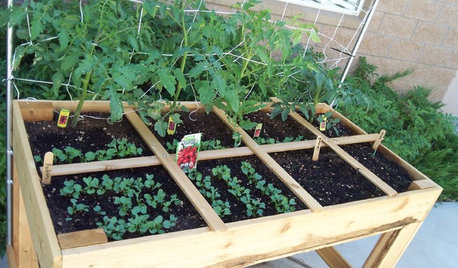
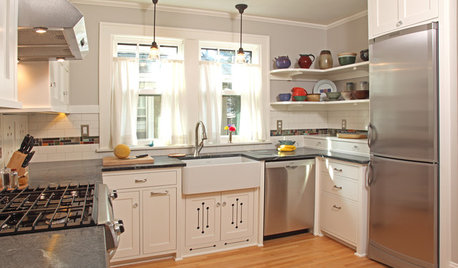
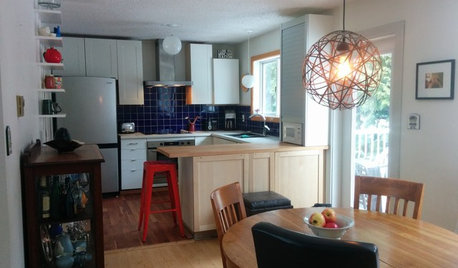
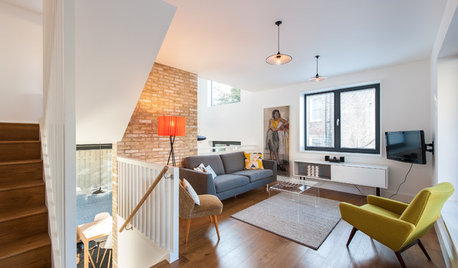
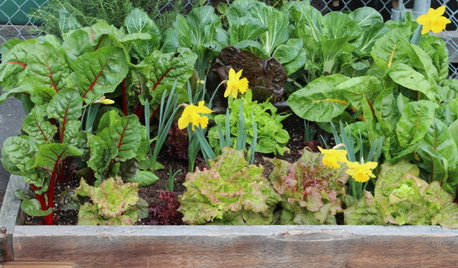
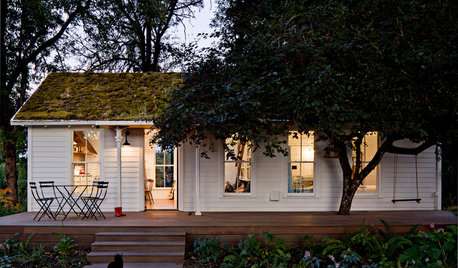
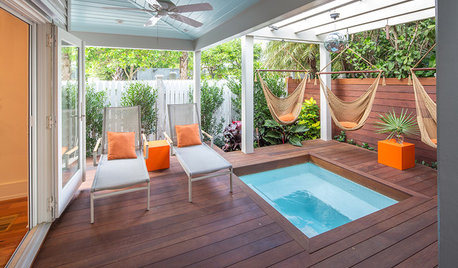

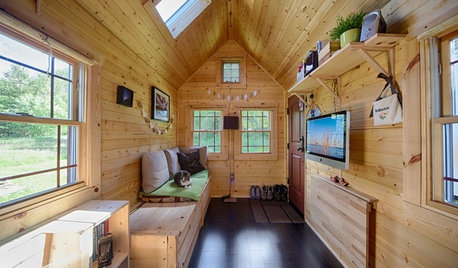
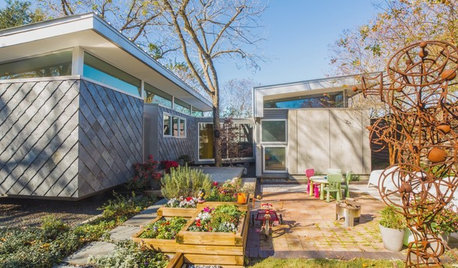






penguingardener